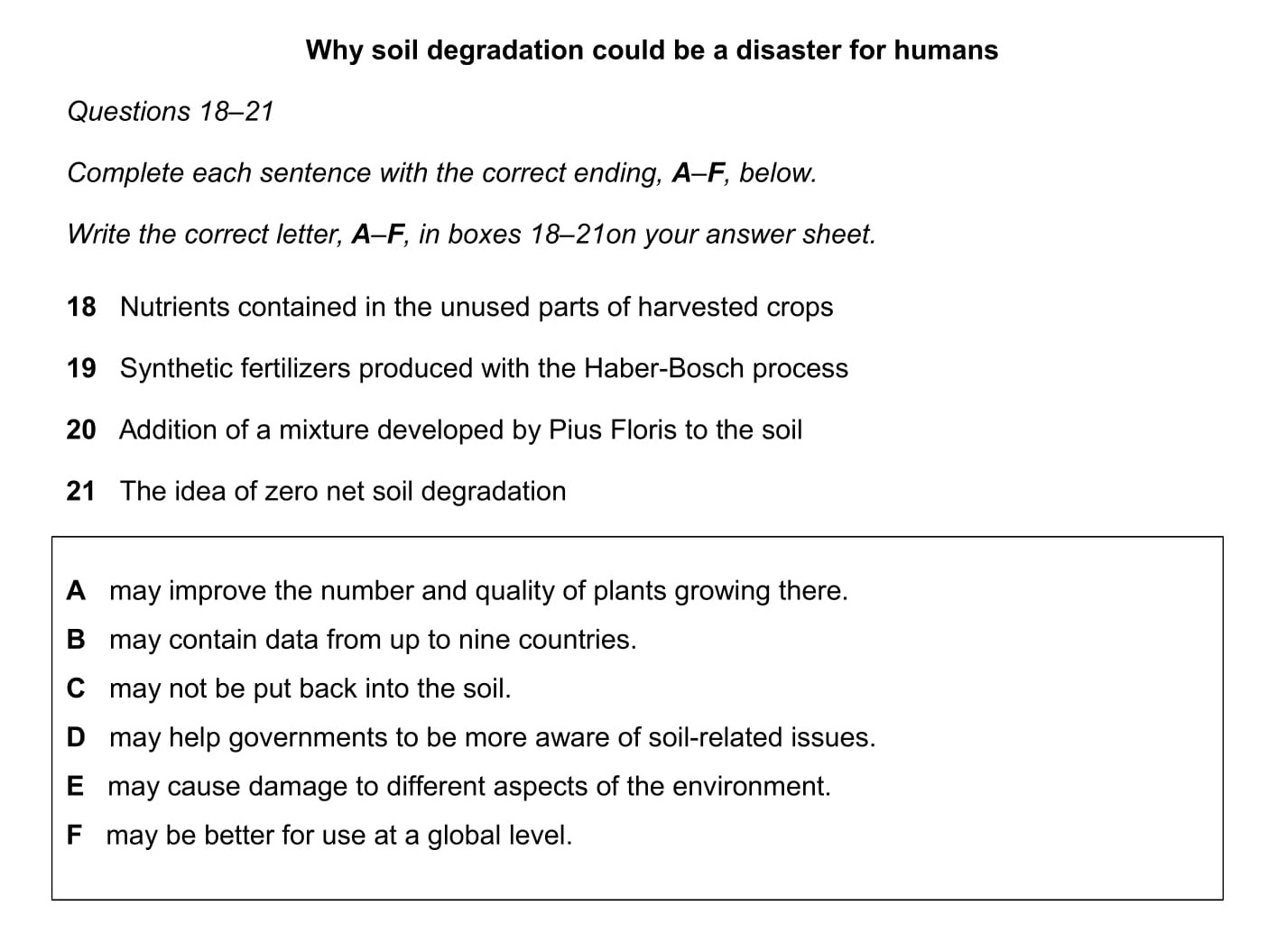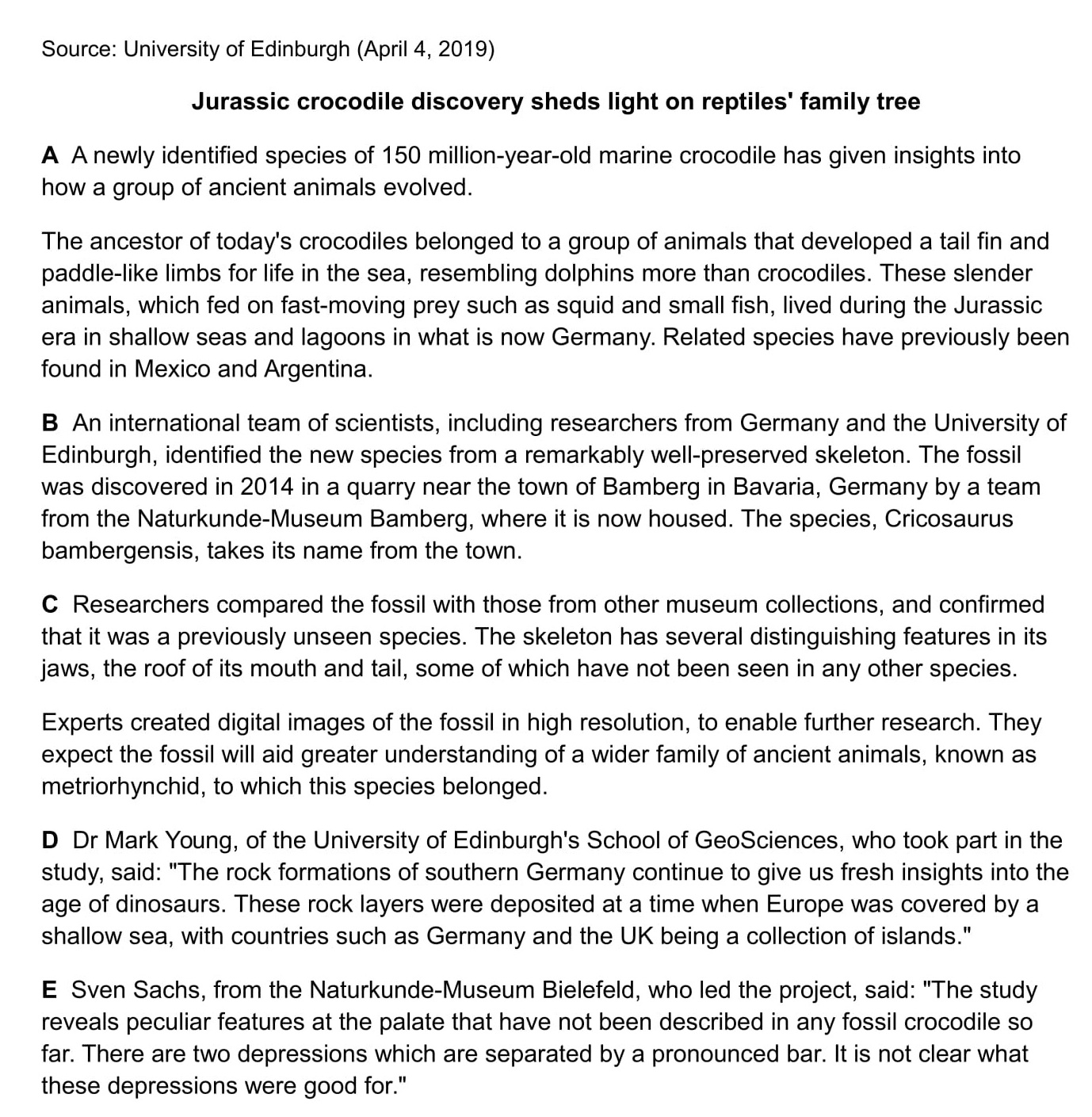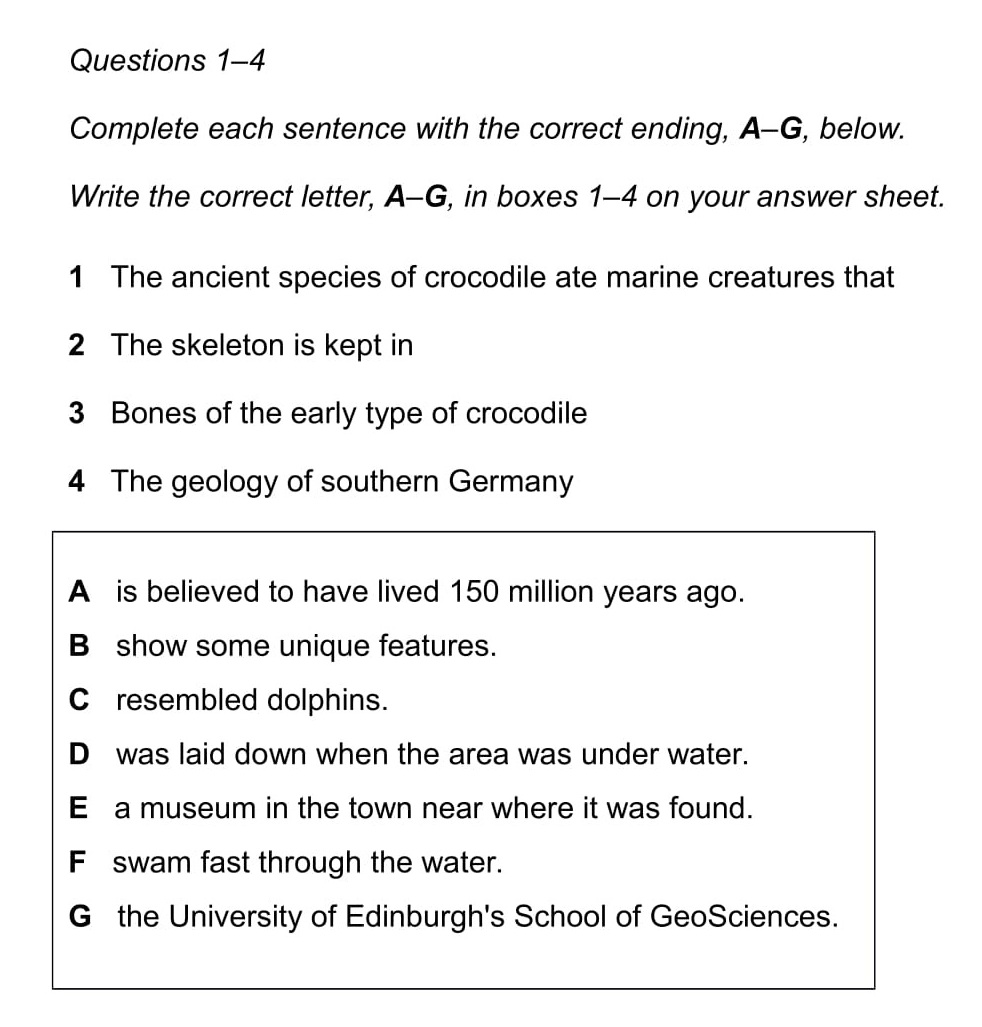IELTS Reading
Matching Sentence Endings
Matching
Sentence Endings questions don’t come up as often as some other types of IELTS
Reading questions but you need to know how to answer them in case you do get
one.
To make sure that you’re well prepared, I cover the following things on this page:
- Explanation of this question type
- Skills needed
- Key tips
- The strategy
- Example
with answers
Explanation of this question type
The instructions will contain two lists:
· A list of incomplete sentences.
· A list of possible sentence endings.
Your task is to match them together based on the information in the reading text.
There will be more sentence endings than beginnings so you won’t need them all.
Here’s an example from a past test paper:

Source: Cambridge English Past Test Paper
Skills needed
This type of question tests your ability to:
- Scan for key words.
- Recognise grammatical structures.
- Identify synonyms & paraphrasing.
- Use context to make predictions.
Key tips
1) The answers appear in the same order in the text as the order of the list of incomplete sentences.
2) Use a process of elimination to select the correct answers.
3) Don’t read the text until you’ve studied the incomplete sentences and the sentence endings.
4) You don’t need to read the whole text in detail, just the relevant sentences.
5) All the sentence endings will appear in the text but not all will match one of the incomplete sentences.
6) Synonyms and paraphrasing will be used. You are matching meaning, not the exact words.
7) The grammatical structure of the two halves of the sentence must match. If they don’t, you have the wrong match.
The Strategy
This is the method I find most effective in answering matching sentence endings questions. I’ll show you how it works in practice in the example test question below.
# 1 Read just the incomplete sentences to start with and try to understand what they mean.
# 2 Highlight key words. This will help you to focus in on the meaning and identify the words you will later scan the text for.
# 3 Now read the sentence endings to get their general meaning.
# 4 Next, start looking for possible matches. Many of the possible sentence combinations will clearly be wrong due either to meaning or grammatical structure. You can eliminate these immediately.
Here’s what to do.
a) Go to the first incomplete sentence and read it carefully.
b) Look down the list of sentence endings and note those that could be a potential match. Write their letter next to the incomplete sentence you’re considering, e.g.
1. B, C, F
2. A, E
You will probably spot at least one obviously correct match straight away and certainly many that can’t be correct and can be quickly eliminated.
This won’t take too long and you’ll end up with a comprehensive list of potential correct answers. Doing this first will narrow down your search considerably when you come to look for the right answers in the text.
(Having completed many past test papers in order to develop this strategy for you, I’ve found that I can generally predict the correct ending for about 50% of the sentences before even reading the text. The remainder I can usually narrow down to two possible answers.
Now I’m a native English speaker, of course, but you should also be able to achieve almost the same level of success if you follow the strategy and heed the tips.)
Another
advantage of starting this way is that you don’t yet need to think about
possible synonyms and paraphrasing that are bound to be present in the text.
# 5 Now it’s time to find the location of the first answer in the text.
Return to the first incomplete sentence and scan for the key words you identified earlier. If there are names, numbers, places or dates that you haven’t already highlighted, include these as key words as they’ll be easy to spot.
I also found myself skimming at the same time to get a general understanding of the text. I wouldn’t normally recommend skimming and scanning together as they are two separate skills but do so if you can and it works for you.
Watch out for synonyms and paraphrasing.
# 6 Once you’ve found the right part of the text, read around the key words for the information to enable you to select the correct answer.
# 7 Double-check that the matched sentence is grammatically correct and fill in your answer sheet. Then, cross through the sentence ending in the list to eliminate it from further consideration.
# 8 Repeat this strategy for the remaining incomplete sentences. Remember that the rest of the answers will come in order in the text.
Example with answers
Please note that this example is not from a real IELTS Reading test paper. I've created it myself to demonstrate the strategy I’ve just outlined for matching sentence endings questions and to give you an opportunity to practice it.
The text in your test will be much longer but will have a similar number of incomplete sentences and sentence endings.
When you’ve completed the task,
read my notes below which contain the answers.


Click this link for a downloadable PDF of the question - Jurassic Crocodile Text & Sentences
Notes on how I answered the questions
1) First, I read all the incomplete sentences and thought about their meaning. I also highlighted the key words.
1 The
ancient species of crocodile ate marine creatures that
2 The skeleton is kept in
3 Bones of the early type of crocodile
4 The geology of southern Germany
2) Next, I read the sentence endings to get their general meaning.
3) I start looking for possible matches and note them beside the incomplete sentences.
1 The
ancient species of crocodile ate marine creatures that C, F
2 The skeleton is kept in E, G
3 Bones of the early type of crocodile B
4 The geology of southern Germany A, D
A
is believed to be 150 million years ago.
B
show some unique features.
C resembled dolphins.
D was laid down when the area was under water.
E a museum in the town near where it was found.
F swam fast through the water.
G the
University of Edinburgh's School of GeoSciences.
There is one clear match – 3B.
3 Bones of the early type of crocodile
B show some unique features.
It’s the only match for sentence 3 that makes sense and is grammatically correct. I did consider ending C (resembled dolphins) but it isn’t grammatically correct so doesn’t sound quite right.
I fill in my answer and cross through B to eliminate it from further consideration.
4) I’m ready to begin looking for the locations of the other answers in the text.
I go to sentence 1 and scan for the keywords I highlighted earlier (crocodile, ate), thinking about possible synonyms as I do so.
1 The ancient species of crocodile ate marine creatures that
I find both ‘crocodiles’ and ‘fed on’, a synonym of ate, in the second paragraph of section one.
A The ancestor of today's crocodiles belonged to a group of animals that developed a tail fin and paddle-like limbs for life in the sea, resembling dolphins more than crocodiles. These slender animals, which fed on fast-moving prey such as squid and small fish, lived during the Jurassic era in shallow seas and lagoons in what is now Germany.
I
now have the location of the answer so go back to the list of sentence endings
and re-read the ones I’ve selected as possible answers.
C resembled dolphins.
F swam fast through the water.
Looking at the phrase after the words ‘fed on’, I see that the obvious match is sentence ending F.
I check that the completed sentence is grammatically correct. It is, so I fill in my answer, cross through ending F and move on to sentence 2.
5) As the answers come in order in the text, I scan on from the location of the first answer for the next pair of key words I’ve chosen.
2 The skeleton is kept in
I spot ‘skeleton’ in the next paragraph but not ‘kept’ or anything that immediately seems to be a synonym. However, on skim reading this paragraph and the next one, the context paragraph B would suggest that this is where the answer is located.
I read in detail, searching for a synonym of my key word ‘kept’. I spot ‘housed’ which is a match.
B An international team of scientists, including researchers from Germany and the University of Edinburgh, identified the new species from a remarkably well-preserved skeleton. The fossil was discovered in 2014 in a quarry near the town of Bamberg in Bavaria, Germany by a team from the Naturkunde-Museum Bamberg, where it is now housed.
I’m
confident that I have the location of the answer so go back to the list of
sentence endings and re-read the ones I’ve selected as possible answers.
E a museum in the town near where it was found.
G the University of Edinburgh's School of GeoSciences.
The first thing I notice is that there’s no mention of ‘the University of Edinburgh's School of GeoSciences’ in this paragraph so this can’t be the right answer and can be eliminated.
The match must thus be E. It’s hidden in the paraphrasing but I’ve got enough clues to know that it’s right so don’t waste time double-checking it. I fill in my answer, check the grammar and move on.
(If I didn’t feel confident enough to do this without being sure, I’d quickly scan the text for ‘University of Edinburgh’ which would be easy to find being a name. If I did this I’d immediately see that the paragraph it’s in has nothing to do with where the skeleton is kept so it can’t be the right answer.)
6) I’ve already found the match for sentence 3 so I can go straight to sentence 4.
7) First I scan for the key word ‘Germany’ as it will be the easiest to find.
4 The geology of southern Germany
I spot it in paragraph D.
D Dr Mark Young, of the University of Edinburgh's School of GeoSciences, who took part in the study, said: "The rock formations of southern Germany continue to give us fresh insights into the age of dinosaurs. These rock layers were deposited at a time when Europe was covered by a shallow sea, with countries such as Germany and the UK being a collection of islands."
I now look for ‘geology’. I can't see it but I know that it’s the study of ‘rock formation’ which is in the text. I'm happy that I've found the location of the answer.
I now go to the two potential sentence endings and look for matching key words and meaning in these.
A is believed to be 150 million years ago.
D was laid down when the area was under water.
Reading the paragraph in detail, I can see no mention of a period of time so doubt that it could be answer A.
Answer D, however, has the phrase ‘the area was under water’ which is a near perfect match for the phrase in the text ‘covered by a shallow sea’. This must be the answer. I fill it in and I'm done.
(If I didn’t know the meaning of 'geology', I could still have found the answer by working with key words in the sentence endings. It's often more a matter of eliminating impossible matches than it is proving the correct one.)
I hope you’ve noticed in this explanation section that I haven’t wasted time reading everything in detail to be sure of the answers. If the clues clearly point to a correct match, it’s almost certainly right.
Time is your biggest enemy in the IELTS Reading test. Make your choice quickly and keep moving on.
Answers
1 F
2 E
3 B
4 D
Want to watch the video of this page? Click here.
I hope you’ve found these
extra notes helpful. Now you’re ready to use this strategy and all the tips to
practice answering matching sentence ending questions from past IELTS Reading
test papers. This practice will quickly improve both your skills and your level
of confidence.
Like this page?
Lessons On All Question Types
For more sample questions with step-by-step instructions, see the IELTS Reading menu page.
More Reading Test Pages
IELTS Reading Test – Understand the format, question types & marking system & know what skills are assessed. Also learn success strategies, key reading skills & discover top tips.
IELTS Reading Skills – Master the skills of skimming, scanning & detailed reading. Understand the importance of topic sentences & how to use context for meaning & unfamiliar words.
Top 7 IELTS Reading Tips – Each tip will take you a step closer to the high score you want. They are the key to top marks in your test.
9 More Tips For IELTS Reading – Learn valuable practice techniques & discover a secret that may gain you extra marks.
IELTS Reading Practice – Discover the top 5 things you must do to prepare for your reading test.
How to Complete the IELTS Reading Test in 60 Minutes – Top 6 Recommendations.
IELTS Academic Reading – Why you should take IELTS Academic Reading, test format, text types &
sample tests.
IELTS General Reading – Why you should take IELTS General Reading, test format, text types & sample tests.
Reading Practice Samples – Short activities to improve your reading skills & help you learn topic vocabulary.









